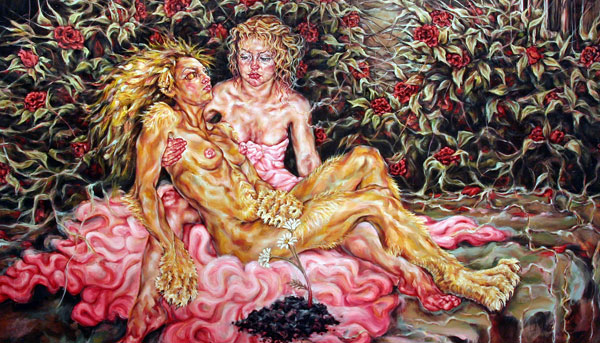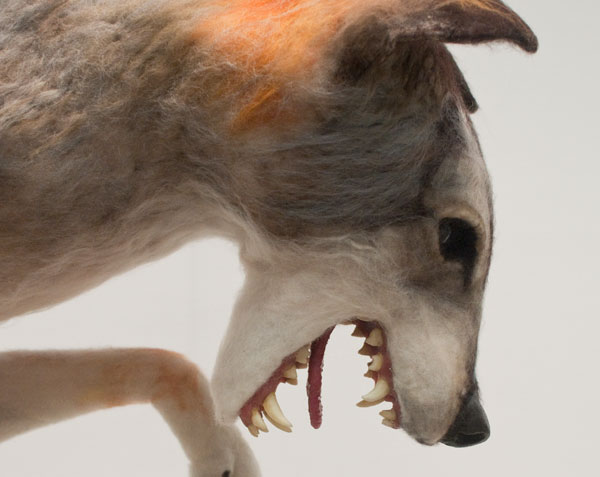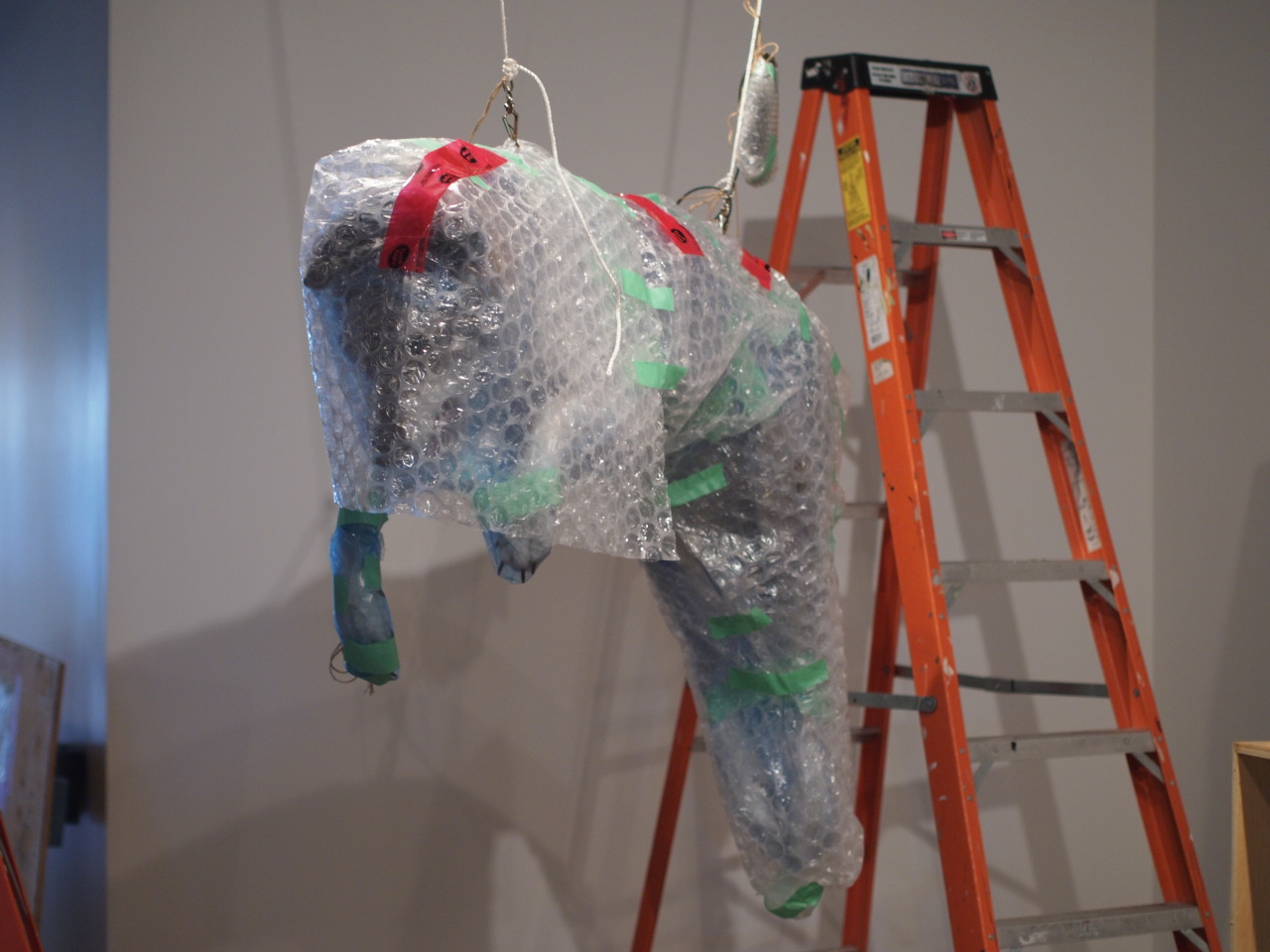Tammy Salzl & Emily Jan | Falling Through the Mirror
March 7 – April 19, 2014
Opening reception and Artist Talk | Friday, March 7 at 7 pm
Tammy Salzl and Emily Jan approach narrative and the monstrous in painting and installation. In their work, they experiment with the ways that the monstrous represents the edges of society’s status quo, but is nonetheless a point of attraction, in stories, mythologies, and art. Their work presents immersive and fantastic parallel realities, and in their large planned installation will suggest places where this might cross over, coming close to our world.
The Chimæra
Essay by jake moore
The Chimæra is a fire breathing female creature of greek myth that was composed of three distinct animals, a lion, a snake, and a goat. She was the daughter of Typhon, the most powerful and heinous of the monsters, who was the last son of Gaia, the primal Greek Mother Goddess, who herself created the earth and the universe. In scientific terms, a chimæra is a single organism composed of genetically distinct cells. Chimærae are creatures and plant life produced through cellular mutation caused by the bringing together of multiple parts. Thus Chimæra – can be understood as a creature of social and scientific reality as well as a creature of fiction, for as we know, all stories are true^1. This mythic tale of monsters and their scientific mirror suggests the role of narrative in coming to know the world - it also evokes family and genesis, the viscous thematics that both propel and inhabit the works of Emily Jan and Tammy Salzl.
The two artists operate in distinct media, Jan in textile informed sculptural installation, and Salzl with paint on canvas, but each operates at a heightened level of skill and with particular attention to additive processes. They each tease out the content of their productions with a layering into, or embedding of, the material as analogue to meaning. I am not intending to describe a sameness here, but a parallel methodology and a shared embodied type of knowledge that comes from the careful making of things. While painters (and photographers) often resist the object nature of their images - it is impossible to deny when the impasto and other tools of the painter in the hands of Salzl, conjure so fully the flesh of a multiply breasted woman, or the exoskeleton of a fetal monster child, or the bulbous presence of a sperm like entity traveling the forest floor. She is not creating pictures of the possible participants in libidinal and animalistic faerie tales, but creating the ground from which their existence can become. Ground here has the double meaning of pictorial preparation but also the Hegelian term, which he meant to describe the conditions for something to come into existence, or "appear". Method of production and narrative strategy are conflated here and the stories brought into being become a shared knowledge, they enter our imaginations and begin to normalize, fiction is left behind.
Jan works from stories already told. She manifests and refigures age old cultural and mythological narratives in densely crafted environs that implicate the viewer in the reconstruction of the tales. The title of her needle felted and embellished wolf in mid air attack, Ragnorok is drawn from the 13th century Norse epic Prose Eddathat foreshadows the death of the gods at the hands of the giants. In the story, the giants are assisted by Fenrir, a monster in the form of a wolf, that is the child of trickster god Loki and a giantess, Angrboda. The wolf figure as constructed by Jan is in mid air, but its suspension is made obvious and of mechanical means. Its fur is dense and haptic, drawing us around the figure warily only to be surprised by the brightly coloured plumage adorning its haunches. The Selkie brings into being the mythological creature found in Scottish, Irish, and Faroese folklore. Selkies are seal people that leave the ocean, doff their skins and walk among humans. Should a man find the seal skin of a selkie, he can hold her captive in marriage. Should the Selkie find her seal skin back, she can return to the waters of her origin and leave behind any hybrid family she has made on land.
Jan builds her characters with deep intention. Needle felted surfaces marry with cast rubber tongues and illuminated eyes so that we believe these beings are alive and among us. Meters and meters of dyed silk conjure entrails and water simultaneously, intermixing the body with the world around it and the natural forces at play. Her stories are restaged so that one might consider the tensions between the natural wild and the myth of civility inherent in the creation, (and destruction), myths of our cultures.
The works of Jan and Salzl together, perform in parallel to the multiple meanings of chimæra, shifting between material and immaterial worlds, prescribing neither as a preferred method of being. Instead, this fluid interchange claims space both physical and psychic which in turn causes us to carry the work forward within ourselves.
-
jake moore is an artist, curator and cultural worker. She has a diploma in furniture design and construction from the School of Crafts and Design at Sheridan College, Oakville, Ontario,and holds both a BFA Sculpture, and an MFA Fibres and Material Practices, from Concordia University in Montréal. She has exhibited widely in Québec and Canada, including solo exhibitions at Parisian Laundry, FOFA Gallery and Optica in Montréal, AXENÉO7 in Gatineau, Walter Phillips Gallery in Banff, Alberta and various venues in Winnipeg, Manitoba. moore is currently the director of FOFA Gallery at Concordia University. She considers the work she does as an educator, social organizer and arts administrator to be part of a hybrid creative practice that conflates labour and public engagement with the reflective and non-verbal practices of making.
1. “All stories are true” is an African saying that is used quite specifically by John Edgar Wideman, as the title of his 1992 collection of short stories about a community of African Americans in Pittsburg. This saying is analogous with the theoretical text, Narration and Knowledge by Arthur C. Danto, “a classic work exploring the nature of historical knowledge and its reliance on narrative”.




